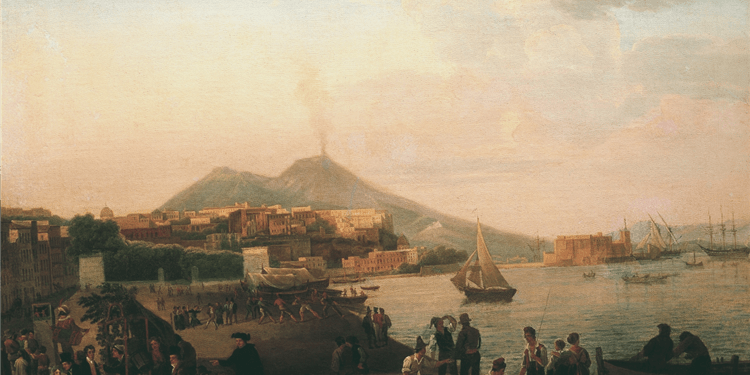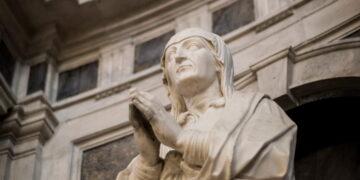Contents
Questo articolo è disponibile anche in:
What do the endless Russian plains have in common with the rocky and sunny southern Tyrrhenian coasts? Instinctively we would say nothing, but history has allowed the natural birth of a long-standing and robust red thread that unites the Russian people with Naples and entire Southern Italy. On one side a strong empire, Third Rome, of Slavic blood and on the other the ancient kingdom of the city of Parthenope, of Greek-Latin lineage. Over the centuries, these two worlds learned to know and respect each other deeply. It was between the 18th and 19th centuries that many southern scholars and artists made their fortune at the court of the tsars.
The irresistible charm of Italian culture
Italy is notoriously the cradle of art, thought and beauty sensu lato of the European civilization. It was precisely the Italian particular sensitivity to beauty that gave rise to the spontaneous construction of this bridge between Italy and Russia. The Russians got to know the Bel Paese through great artists and architects who were wisely invited to the Muscovite lands as early as the 15th century. For example, the reconstruction of the famous Moscow Kremlin was entrusted to Antonio Gilardi from Vicenza in the late 15th century by Grand Duke Ivan III.
This strong admiration on the part of the Russians towards Italian ingenuity only grew in the following centuries. In the 18th century, imperial attention was attracted in particular by the vibrant Neapolitan musical school. In fact, eighteenth-century Naples was one of the main European centers of Opera, whose temple was famous San Carlo theatre, the oldest modern European theatre. It is precisely from the Gulf of Naples that Francesco Araja, the first exponent of the Neapolitan Opera school, arrived in St. Petersburg.

Credits: ar.culture.ru
His skill as an opera composer earned him an appointment as Chapel Maestro at the Romanov court in 1735, a title that he retained between the reigns of Empress Anna and Elizabeth. His theatrical performances were often set in scenarios linked to Greco-Roman history and classical mythology in line with eighteenth-century neoclassical taste. Araja was thus like a pioneer: after him, many other Neapolitan subjects were called to imperial St. Petersburg by will of the tsars and tsarinas.
Among these it is right to remember Giovanni Paisiello from Taranto, a skilled composer, and Neapolitan Domenico Cimarosa, excellent singer, playwright and playwright. But not only Opera: Naples also provided one of the main architects for the expansion and magnification of the capital St. Petersburg. We are talking about Carlo Rossi, naturalized Karl Ivanovich Rossi in Russian, son to a Neapolitan dancer of French origins and to a Russian opera dancer of the same French origins.

Credits: Wikipedia.
The French-Neapolitan was invested with the noble task of making the city of Peter the Great even more majestic. His style was grandly dry, favoring a sense of imperial seriousness. He designed the Mikhailovsky Palace, the Alexandrinsky Theater, the Senate and Synod buildings, the facade of the Russian National Library and many other buildings. St. Petersburg was in no way absolutely alien to the Italian style. It was a stylistically Italian city already from the beginning.
A few years after its foundation in 1703, Florentine Bartolomeo Rastrelli became the main architect of the new capital, giving it that majesty and harmony typical of the Italian sense of measure. But the relationship between the Bel Paese and Russia was not one-way. Great Russian artists also came to Italy, making known the profound soul of the Slavic people.

Credits: artsdot.com
Landscape painter Sylvester Shchedrin is significant among these, trained at the Imperial Academy of Arts. He visited Italy for the first time in 1818 in the aftermath of Napoleon’s defeat and the Congress of Vienna. He was struck by the beauty of the Peninsula, so much so that he never left it again. He studied the great masters of the past in Rome and soon attempted wonderful paintings of the Eternal City and Naples. His representations of the southern capital and other famous places in Campania such as Capri and Sorrento are well known, where he died in 1830 at the age of just 39. His brush was so refined that it influenced Neapolitan art itself, becoming one of the founders of the Posillipo School.
Dostoevskij and Naples: geographically far but innerly close
During the nineteenth century another Russian also visited Italy and fell in love with it: Fyodor Dostoevsky. The Muscovite genius processed the immeasurable beauty of the Bel Paese, internalizing it within his immense Russian soul. In Florence he wrote his novel “The Idiot” in 1868, a true masterpiece of world literature. It is within this work that the meeting between Dostoevsky and Naples gave birth to a significant aphorism about the city: “Naples is a place where the Earth breathes mystery“.
The writer saw in Naples a sort of new Jerusalem, a place where everyday life is not “mud”, but authentic and unfiltered beauty. We could identify a connection between his most famous aphorism “мир спасёт красота” (beauty will save the world) and the mystical and salvific conception that Dostoevsky had for Naples. The capital of the South is not dominated by that bourgeois falsity or by monstrous modernity. In it, the ancestral Greek origins coexist with the Roman expansion, the proud medieval period with the Spanish modern spirit.

Credits: Thought.Co
Naples has been many things, but it exists as such: it has not been dissolved, but has been preserved by curiously observing the other. We can highlight here a substratum that binds Neapolitans and Russians, despite the contingent differences. Dostoevsky puts beauty (красота) at the center in the light of its ontologically just and salvific nature, along the lines of the Greek “καλὸς καὶ ἀγαθός” (beautiful and good). According to the Greek civilization, beauty was an expression of balance, well-being, correctness.
The truth could only be corresponded by beauty. This assumption is in fact equally shared by Dostoevsky’s thought who sees in beauty a connection with a past not devoured by growing nihilism of the modern world. It is possible to identify a parallel on the idea of beauty for the Russians and for the Neapolitans. The use of the adjective “bello” with the meaning of “good” in the Neapolitan language is symbolic, a clear legacy of the city’s Hellenic origins.
The Russians tend to decline beauty as a sacrifice: it nestles among the harshness of life, like an eschatological hope. It is the mirror of the harshness of the Russian climate and nature, as wonderful as it is arduous; as well as Russian history, as rich as it is painful. The Neapolitan, on the other hand, tends to consider beauty as an essential and comforting element. It is not a subdued hope, but a joy to be expressed. Here you can see the Mediterranean climate and nature being so sunny, prosperous and favourable.
However, the soul of the two peoples is almost the same: Russians and Neapolitans are capable of great introspection, skilled in analyzing the complexity of reality in its naked entirety. The only difference appears in the way of experiencing this awareness. The Russian is reserved, thoughtful, melancholic, introverted. The Neapolitan is participatory, ironic, nostalgic, extroverted.
One is the extroverted or introverted version of the other, with the same vision of the world underlying it. Luciano De Crescenzo would state that Neapolitans and Russians are both “people of love“. The Neapolitan people, and more generally the South of Italy, are for the Russian people the negative of the same photograph. This was perhaps what Dostoevsky loved so much about the city of Frederick II.
Not only culture: diplomatic relations between the Kingdom of Naples and the Russian Empire
It was not only culture that created a solid relationship of mutual respect between the Mediterranean kingdom and the Eurasian empire. St. Petersburg saw Naples as a potentially crucial ally for Russia’s atavistic quest to have permanent bases in warm seas. Diplomatic relations officially began in 1779 when Count Andrey Kirillovich Razumovsky was appointed as the first Russian ambassador to Naples as well as on the entire Italian soil.
This climate of collaboration also allowed the birth of a very lively Italian community in the new city of Odessa, founded by Neapolitan nobleman De Ribas by will of tsarina Catherine II the Great. The cordial attitude changed into a spirit of true alliance in the aftermath of the Restoration. In fact, both the Kingdom of the Two Sicilies (the new name given to the Kingdom of Naples after the Congress) and the Russian Empire positioned themselves as reactionary and traditionalist bulwarks in new Europe.
Naples could have been a sort of appendage of the Holy Alliance, as well as an excellent point of support for the geopolitical aims of St. Petersburg. These geopolitical conjectures coincided with a favorable cultural climate, but also with a sincere friendship born spontaneously between the rulers of their respective kingdoms. Tsarina Alexandra Fёdorovna, wife of Tsar Nicholas I Romanov, found herself struggling with a heart aneurysm diagnosed in the summer of 1845 shortly after the death of her daughter.

Credits: Wikipedia.
The court doctors recommended that she spend the summer in a much warmer and drier place than the humid Gulf of Finland. The choice fell precisely on the Kingdom of the Two Sicilies, given the profound knowledge of Italy from Tsarina’s brother, Friedrich William. The empress stayed in a small villa in Butera, near Palermo, made available by Princess Shahoskoy. The wife was accompanied by the Tsar himself, who however remained there for only forty days due to political duties. Aleksandra experienced an enormous improvement in her health, so much so that she remained in Sicily until the spring of 1846.
At the moment of their departure, the imperial convoy decided to stop in Naples so as to be able to thank Neapolitan sovereign Ferdinand II for their pleasant stay. Here Nicholas I met the Bourbon king for the first time and he appreciated his good manners and friendliness. He advised the Neapolitan sovereign to always distrust the English Empire and to cultivate cordial relations with France and Austria. Having returned to St. Petersburg, the Tsar decided to donate to the city of Naples four equestrian statues that had been present on the Anickov Bridge over the Neva River since 1841.

Credits: Napoli Turistica.
This gift was transported by ship to the Mediterranean city by a renowned sailor from Procida who completed the task without unexpected events. These statues are today placed at the entrance to the gate of the Royal Palace overlooking the Maschio Angioino. The tsar was not only amazed by the scenic beauty and the historical-artistic richness of the kingdom, but also by the advanced scientific and technological centers such as the Zoological Station, the Royal Observatory, the Royal Topographical Office and the Royal Factory of Pietrarsa. The latter had allowed the construction of the first Italian railway line in 1839, Naples-Portici.
The tsar, in fact, took it as an industrial model, replicating Pietrarsa factory on the island of Kronstadt. Ferdinand II always honored his friendship with Nicholas, so much so that he categorically refused to participate in the Crimean War (1853-1856) despite Franco-English pressure, even continuing trade with the Russian Empire. But the defeat of the Russian ally would be one of the reasons for Garibaldi’s victorious invasion of the Neapolitan kingdom in 1860.
Russia, weakened militarily by the Crimean war, found itself unable to provide adequate assistance to its ally attacked by Garibaldi’s irregulars. Russian Foreign Minister Alexander Mikhailovich Gorchakov could not help but present his complaints, stating that “if Russia’s geographical position permitted it, its Lord would have been willing to take up arms to defend the Bourbons of Naples, regardless of the non-intervention proclaimed by Western Courts“.
Not even the heartfelt appeal to the other European chancelleries could stop Garibaldi’s invasion protected navally and diplomatically by London in which Nicholas I had already identified a reason for future destabilization of the Mediterranean. However, the fruitful and extensive socio-cultural relations between Naples and Russia would not stop as evidenced by Dostoevsky’s words or the writing of the song ‘O Sole Mio in 1898 in the city of Odessa.
This song would later even be sung in space by Juri Gagarin on April 12, 1961. Curiously, it was a Russian who literally brought the Neapolitan language into space. What remains of all this today? A lot, to be honest. Although not many people know about this ancient bridge that unites Italy to Russia, it lives independently in the souls of the two peoples. Like it or not, aware or unaware, we are always the result of the centuries and millennia of history that preceded us.
Stay up to date by following us on Telegram and Instagram!



















